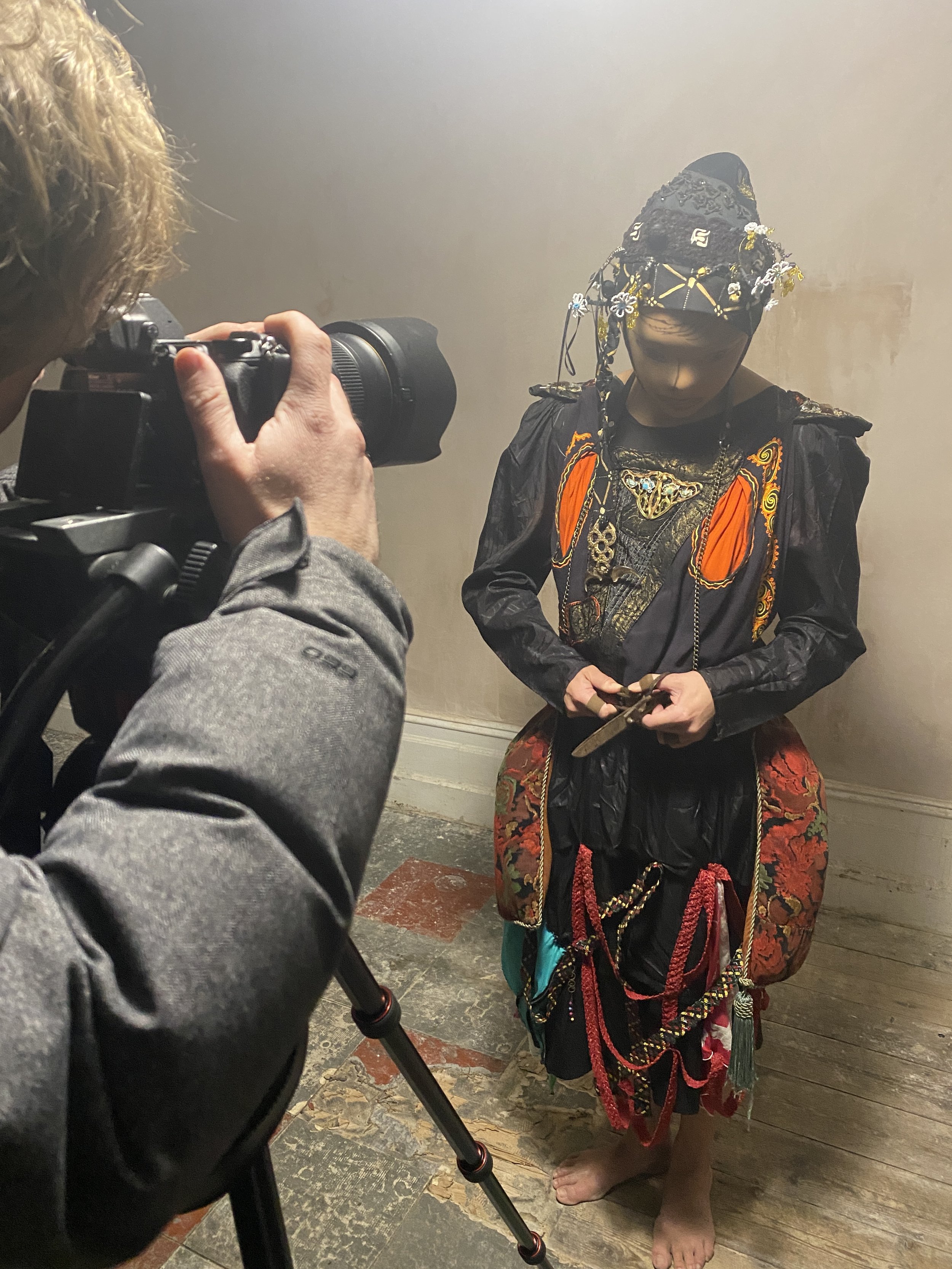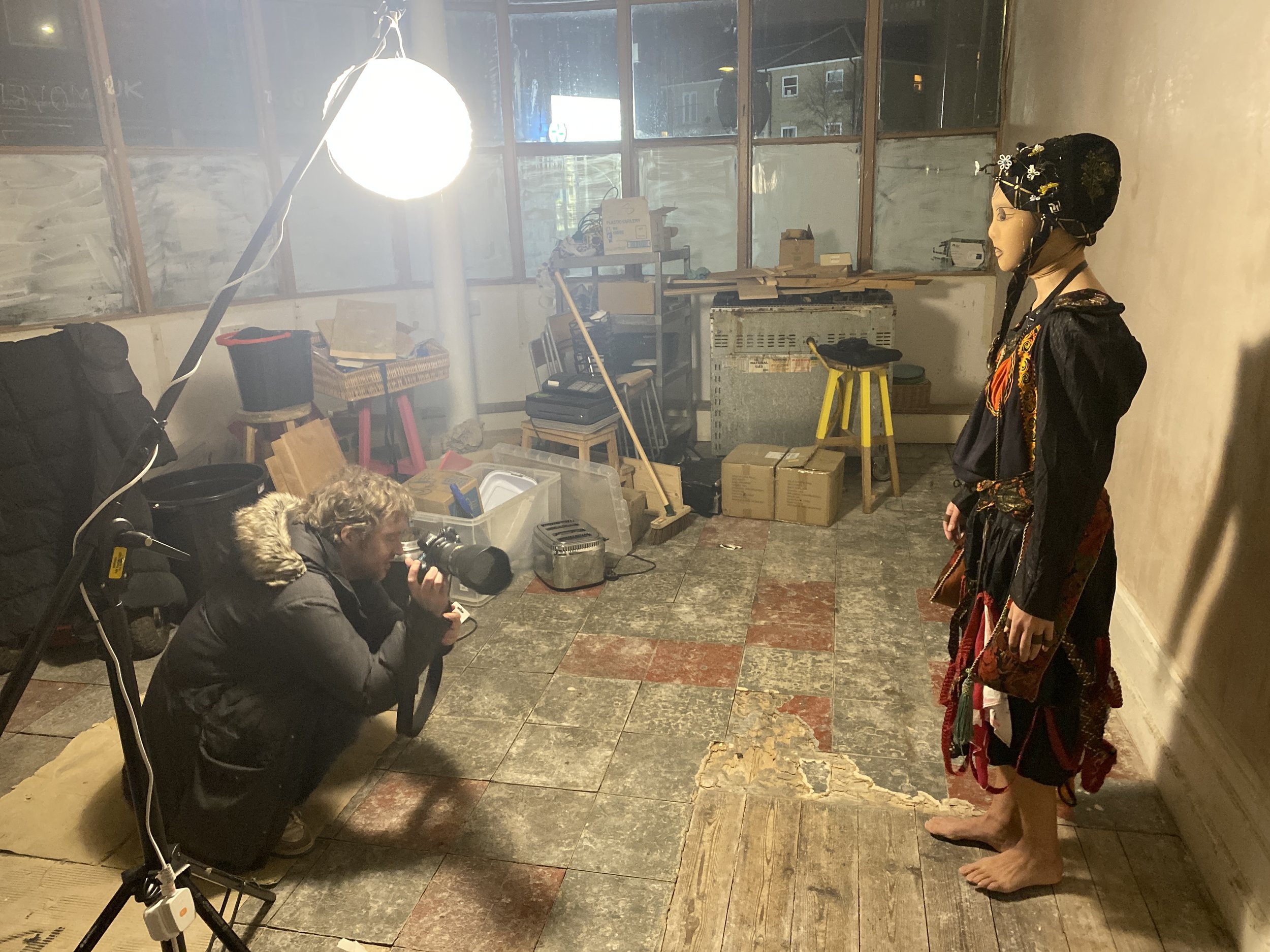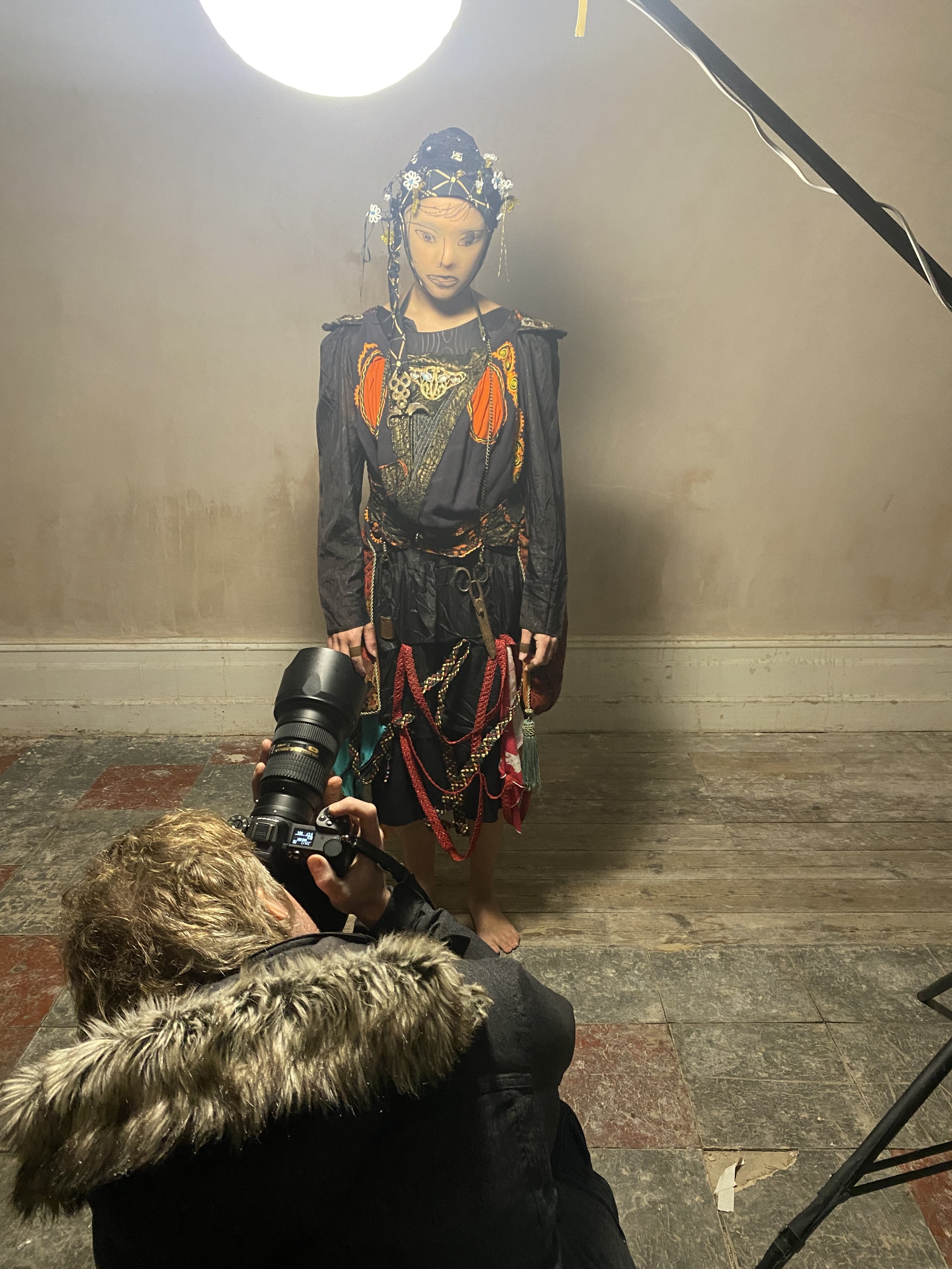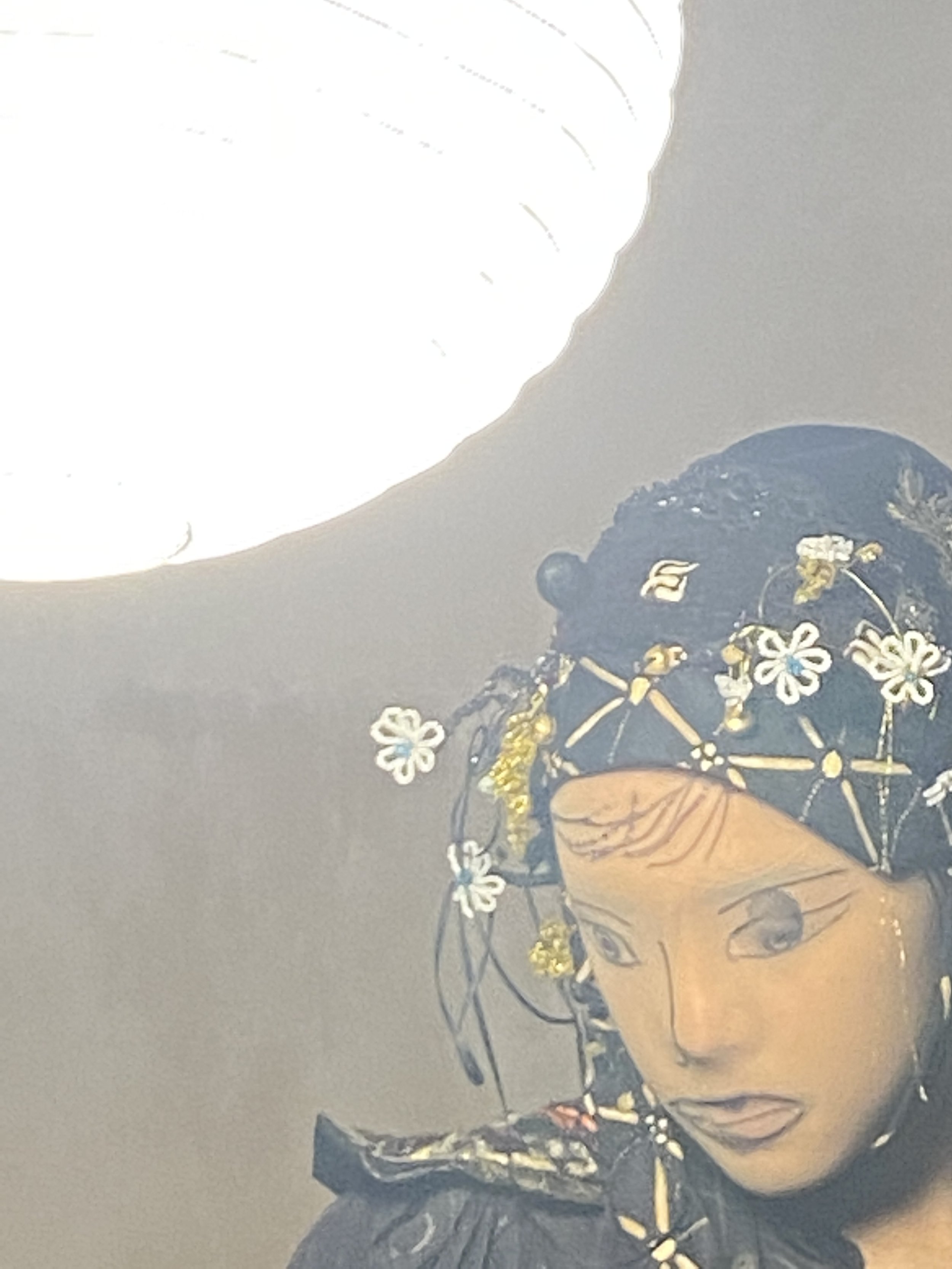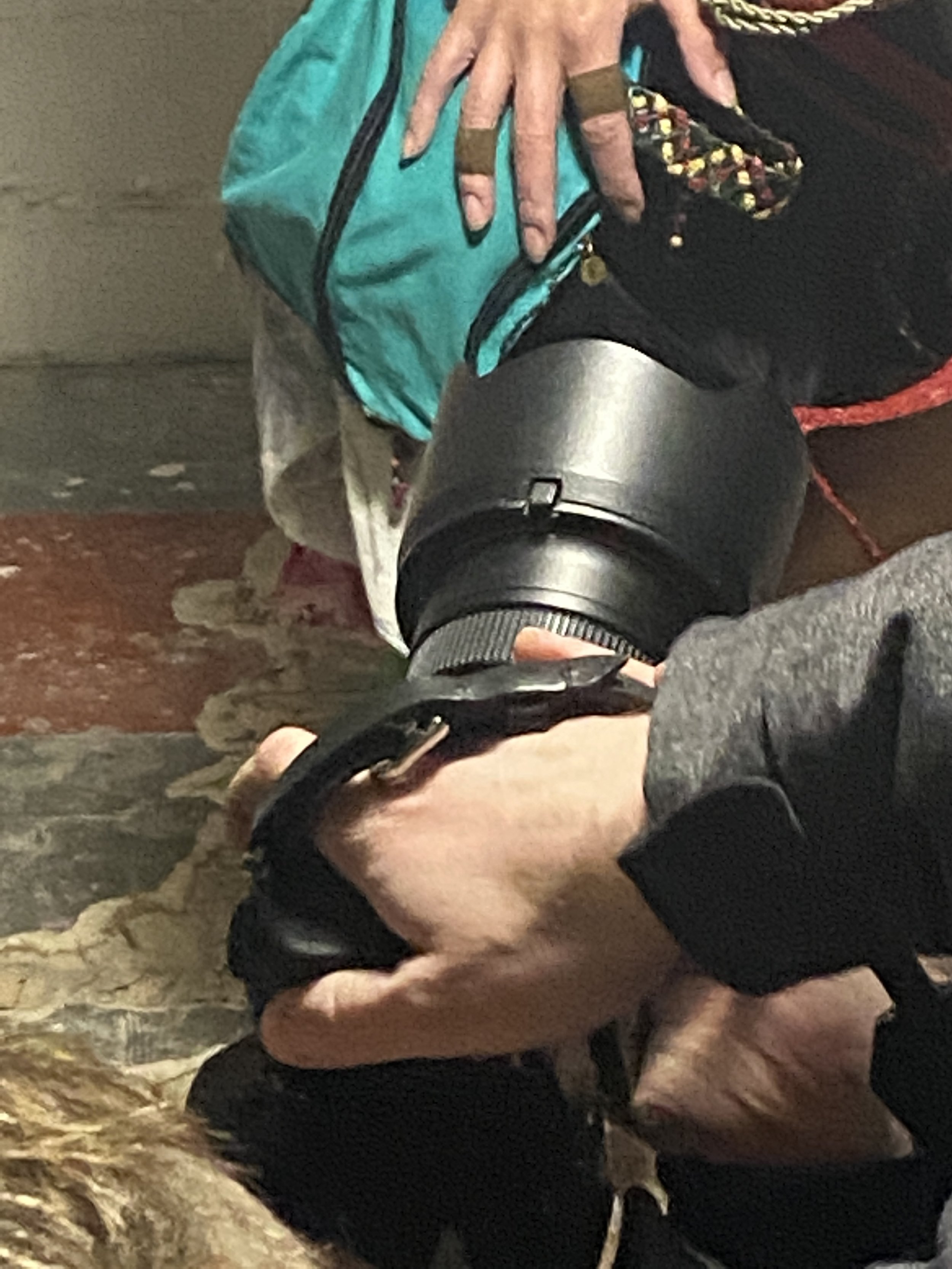Toutes les larmes de mon corps
All the tears of my body
Is a collaboration between the UK based CUT collective and French Textile Artist, Emmanuelle Premel-Cabic.
‘Toutes les larmes de mon corps’ fait partie d 'une série de trois robes, intitulées ‘les guerrières’ et réalisées en 2020. Cette robe sculpture est un réceptacle spatio-temporel, un lieu de recueillement, un sanctuaire de toutes les larmes, chagrins, mémoires invisibles de la chair, emmagasinées dans le corps: une sorte d’adieu et d'hommage, une volonté tenace d aller vers la joie. Elle en porte la signification, par les matériaux textiles et anciens utilisés comme ces mouchoirs suspendus de larmes, son robinet zizi pour les faire s' écouler, ses ciseaux pour couper les liens négatifs: c’est une sculpture de passage d un état à un autre, un rituel, une libération, une guérison.
‘All the tears of my body’ (ATTOMB) is part of a series of three dresses, entitled the warriors’ and made in 2020. This dress sculpture is a space-time receptacle, a place of recollection, a sanctuary for all the tears, sorrows, invisible memories of the flesh, stored in the body: a kind of farewell and homage, a tenacious will to go towards joy. She carries the meaning, by the textile and ancient materials used as these handkerchiefs suspended of tears, his cock to make them flow, his scissors to cut the negative links: it is a sculpture of passage from one state to another, a ritual, a liberation, a healing.
Emmanuelle Premel-Cabic (01/04/22)
un réceptacle spatio-temporel
un lieu de recueillement
un sanctuaire pour toutes les larmes
les mémoires invisibles de la chair
une sorte dadieu et d'hommage
une volonté tenace d'aller vers la joie
uneAutre rencontre, inattendue dans la précarité
elle se rend en Angleterre
suspendue dans une chambre
elle commence à bouger, à respirer
un corps porte son poids, ses larmes
deux âmes se heurtent
deux femmes se murmurent des secrets
longtemps cachés et non découverts
tous retiennent leur souffle
une nouvelle forme émerge
un cocon textile, comme un insecte
Les spectateurs murmurent "Quelle sorcee
ce là ?"
Toutes les larmes de mon corps
une sculpture du passage d'un état inconnu à
unAutre
The CUT collective (choreodramaturg-unsteady states-turbulence)
The CUT collective are a group of professional artists working in film, fashion, performance and music.
The (film) projects are organised at the last minute based upon the availability of the artists. The work is instant and involves minimal preparation as a deliberate attempt to invoke and explore turbulence, precarity and Disorder as a disciplined and rigorous state of working: to create what I call the ‘unsteady state condition’.
CUT collective members working on this project:
Paul Sadot (Choreodramaturg)
Rob Baker Ashton (DOP)
Kat Collings (Dance Artist)
ICY Audio Visual (Music)
Alice Underwood Films (Editor).
Toutes les larmes de mon corps takes textile sculpture as a starting point through which to explore and unearth the movement that is housed and hidden within the creation story of the sculpture.
The collaboration began in December 2021 with a chance encounter between Emmanuelle and Paul when he was visiting the small town of Morlaix in France and he entered her workshop. Intrigued and viscerally moved by the sculptures and the process of their creation Paul brought one of them back to the UK and began to gather CUT collective members for this new project.
Phases of Research and Filming
The project went through two phases of filming with four weeks between each phase.
The first phase was shot during daylight hours and a three hour improvised session in the unused area of a friends shop in Margate. This initial phase allowed the collective to gather and film. Following this we were able to review and explore the footage through a dialogue between editing, sound, sculpture and a deep contemplation of the movement.
The second phase was organised at the last minute, and, through unplanned circumstances, was shot at night using just one light during a two hour improvised session. We entered the second session with a clearer framework of turbulence that allowed a more rigorous approach to the Disorder we deliberately invoke as a creative method of working as a collective. It was amidst this turbulence that the life of the sculpture emerged. When filming the second phase we saw that Kat appeared inhabited by the sculpture or perhaps vice versa and Robbie and myself became hypnotised, or perhaps bewitched, by what we were viscerally feeling and experiencing in the small, intimate, space of filming.
The Scenes
We shot four wides and several rounds of mid body and head close ups as well as hand held footage. But, having seen/felt ‘live’, and on film, the power and the dialogue between Kat and the sculpture moving each other within the space, I chose to curate three scenes (1,3,4) from the wides as a start to the sharing of this work: Unedited and worked upon in post production through the processes of colour grading and sound architecture. Scene 2 was a much longer take and I approached this as a septette entity to the other scenes.
Emmanuelle Premel-Cabic - Processual Approach
The process with which Emmanuelle makes her work is based upon turbulence, personal corporeal narratives, female identity, embodied reflexivity and chance encounters with found objects. Her practice is intuitive and heuristic and involves a unique empathetic encounter with found objects, textiles, and other materials, wherein she searches for histories, lives and emotions hidden within them. Emmanuelle’s workshop is a wonderous and complex Aladdin’s cave of textile materials, found objects and sculptures. The immersive nature of her research space(s) allows her to dwell within the multitude of materials and, in doing so, develop intricate spatio-temporal connections to them. In this way, Emmanuelle is able to re-imagine pasts, presents and futures through the evolution of her work.
Photo: Rob Baker Ashton
Paul Sadot - Processual Approach
The geological use of the term ‘accretion’ denotes ‘the imperceptible accumulation’ of material relating to time (Anand, 2006). I use this definition to refer to the wider process of osmosis between practice and theory that has occurred through my practice research. I use ‘processual accretion’ to house the idea of myself as an artist becoming more porous in a subtle internal shift, which has enabled me to absorb sociocultural and political themes. These themes arise from the iterative cycle of doing and reflecting wherein I apply a wider sociopolitical lens, which impacts on my work by implicating the physical and perceptual movement(s) of dancer(s), spectator(s) and myself. I use ‘processual accretion’ to capture the processual and accumulative nature of what I do, to place the physicality of my work in dialogue with theoretical ideas, enabling a space of dialogue to occur between practice and theory. This enables me to absorb political themes and trends that imbricate my practice, some of which might already be present in dancers’ bodies or the lived spaces in which we move.
“Theatre practitioner and researcher Eugenio Barba argues that contrary to the image of disorder that it invokes, turbulence is in fact ‘order in motion’. In the studio, this ‘strategy of disorder’ challenges and denies mimesis and clichéd illustration; moreover, it confronts individual and collective tropes that risk becoming nostalgic and burdensome in the research context. Barba came to describe a similar notion, through the term ‘Disorder’. Using an upper case rather than lower case ‘D’, to avoid confusion with the disorder of undisciplined chaos, Barba writes that Disorder is ‘the logic and rigour which provoke, the experience of bewilderment in me and the spectator’ (2010). Drawing from this idea of Disorder as a logical and rigorously invoked process, my practice explores ‘reliable frameworks of turbulence’ in the studio” (Paul Sadot 2019).
Kat Collings - Processual Approach
With this process I really tried to tune into what the costume felt like and meant to me as I wore it. I was always thinking, ‘how do I make sense of this and for the viewer to be able to read my feelings through the clothing’. It proved challenging as the pieces were so delicately made: with such intricacy. I was wearing the artist’s sheer hard work, I could feel it, a lot of time and effort had been put into these beautiful pieces, as well as the style of the clothing that shadowed my movement.
There were a lot of components, the first time the room was very cold and I had cold feet, which gave me a raw sensitivity that I was reacting within that very present moment. This character I had grown into had morphed within the room, the room being a part of the characters “home” lets say.
The second time we filmed it the room was warmer and my body was really warm which brought out a different feeling from within, I guess more comfort, but with that comfort I also became very diligent with my movement because I didn’t want to go into old habits and be complacent with what movements felt nice, I had to focus and bring my attention back to stay true to the sculpture I was within and conveying that story.
I think the temperature had a bigger role than intended, as with both experiences a warm room and a cold room helped me tap into more worlds with my movement. Experiencing the character in reality. I would be interested to see how different surroundings would enhance the characters movment and being, it’s like a real life ghost we are manipulating from within. Between shoot 1 and 2 I had time to reflect upon the movement and the second shoot was completely different. I felt more in tune with what the sculpture I was wearing was trying to say. The music carried my flow and naturally a story appeared and I navigated those emotions, I found in some takes I would just explore one emotion.
I remained in character and between takes I didn’t really talk much. I stayed silent not really wanting to come out of the zone I had entered. I really started to embody whoever this woman was and what she was doing. Take after take I kept questioning in my head, what am I doing? What kind of people do I know? Have I experienced death? Do I have a sense of humour? Overall sadness hung over much of my movement but I began to explore how sadness can also be uplifting and humorous, and when I discovered the scissors on my skirt piece I suddenly started bouncing with movement and it became quite sinister, I felt that was the moment that I wasn’t the victim.
“Those who believe in the vital importance of not having profit and self-profit as the only goal for life and its arts. It is a situation very hostile to and impatient with, those who create the non-recognisable and don’t care about being recognised” (Andre Lepecki 2016).
Scene 2
I wanted to use this longer one take wide shot of Kats improvisation and to sound scape it by exploring already existing music by artists whose work I follow, and whose elements of turbulence within that work seemed suited to explore in relation to the movement.
I placed this piece of music in its entirety on to the film and in doing so it enabled me to view the movement in a new and unexpected way: even to the point of allowing the silent stillness at the end
Music: Lost and Found by Andy Stott (with very kind permission)
a space-time receptacle
a place of recollection
a sanctuary for all the tears
invisible memories of the flesh
a kind of farewell and homage
a tenacious will to move towards joy
anOther encounter, unexpected amid precarity
she travels to England
hanging in a room
she begins to move, to breathe
a body bears her weight, her tears
two souls collide
two women whisper secrets
long hidden and undiscovered
all hold their breath
a new form emerges
insect-like from its textile cocoon
"What sorcery is this ?" the on-lookers murmur
All the tears of my body
a sculpture of passage from one unknown state
to anOther

